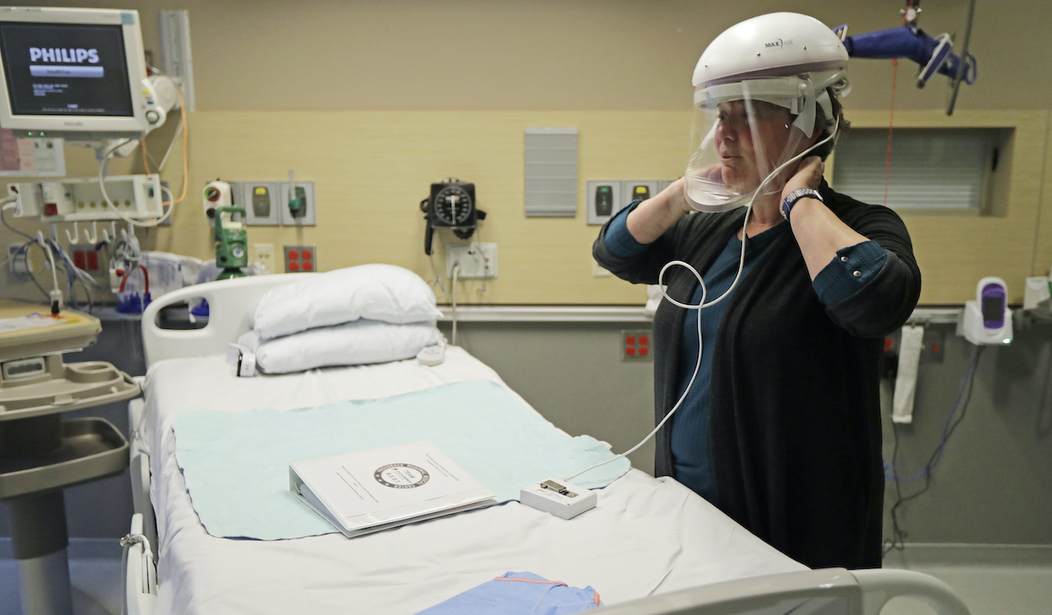Here’s another example of something that’s meaningfully different about Omicron relative to previous variants which COVID deniers insist is similar. Those who were saying “it’s just the flu” of the original Wuhan strain in spring 2020, as elderly New Yorkers were dropping like flies, now cite as vindication the fact that Omicron really does present as more of a flu-like illness in most people. (Never mind that that’s partly due to a huge amount of immunity acquired across the population over the past two years.) The same people claimed that many who landed in the ER in 2020 and 2021 were being hospitalized with COVID, not for COVID. That is, supposedly they were suffering from unrelated health problems that required hospital care and were only testing positive incidentally upon admission. Counting them as “COVID hospitalizations” inflated the numbers, they told us, which in turn allegedly made the disease appear more threatening than it was.
Eight hundred thousand deaths later, that reasoning is plainly insane. The acid test of how deadly the virus has been is the “excess death” total across the 50 states. If COVID were only turning up in people who were going to die anyway of other causes, we shouldn’t have seen an increase in excess deaths over the past 21 months. Instead:
This is unquestionably, undeniably, not true. Here are charts of deaths officially attributed to COVID and deaths in excess over previous year baselines. Somehow, deaths officially attributed to COVID line up almost perfectly with excess deaths. https://t.co/YnVVcxQSvt pic.twitter.com/QXju3RzvWn
— Kevin 👐 Glass (@KevinWGlass) January 3, 2022
The Economist has some great visualizations of this, even on a state-by-state basis in the US. Red line is excess deaths. Shaded area is deaths officially attributed to COVID. This “with/from” idea is just straight up wrong. https://t.co/h5IItWdJoi pic.twitter.com/0vKb3nDT6T
— Kevin 👐 Glass (@KevinWGlass) January 3, 2022
It’s true that some hospitalizations have been “incidental” throughout the pandemic but until recently a rise in COVID cases would reliably predict a rise in hospitalizations which would then reliably predict a rise in deaths. With Omicron, that’s no longer as true as it once was. The combination of a milder variant and greater population immunity means that a larger share of people who test positive for COVID in the hospital really are there with COVID, not for COVID. Anthony Fauci acknowledged that a few days ago. Scott Gottlieb did the same yesterday:
"We don't have good data in the U.S. on how many people are being hospitalized and they are incidentally picking up COVID," says @ScottGottliebMD. "About 20% of hospitalizations [globally] were incidental….I would suspect that it is higher during this wave." pic.twitter.com/hrLKrInrgr
— Squawk Box (@SquawkCNBC) January 3, 2022
How much higher is the share of “incidental” hospitalizations during the Omicron wave? There’s no national data about it from the U.S. as far as I know but the local data here and the national data abroad are intriguing. A few days ago, UK authorities reported that fully one-third of people hospitalized in the UK who’ve tested positive are there for reasons unrelated to COVID. In South Africa, one small study found that the share of “incidental” hospitalizations was almost twice as high:
OMICRON: Hospitalizations from Omicron compared to previous waves, large study, S. Africa:
-63% of patients hospitalized had incidental COVID (in nose, not there for COVID)
-Of those with COVID, 45% needed oxygen compared to 99.5% previous waveshttps://t.co/aaKsI8QdNY— Monica Gandhi MD, MPH (@MonicaGandhi9) January 3, 2022
And in the U.S.?
I can tell you that at the two public hospitals in LA for which i review all Covid + tests, at this point only 1/3 of Covid+ admissions are admitted because of Covid. And only 20-25% +tests in ED are admitted. Agree, reliance upon administrative data is misleading.
— Brad Spellberg (@BradSpellberg) January 1, 2022
Jackson Health System hospitals currently have 439 patients who have tested positive for COVID-19. Of those, 220 patients – or 50% – are admitted to the hospital primarily for non-COVID reasons.
Of the 439, 96 are vaccinated; 46 of whom are immunocompromised transplant patients.— Jackson Health System (@JacksonHealth) January 3, 2022
Omicron is a different kind of COVID, obviously, and yet left-wing restrictionists and right-wing anti-restrictionists are each resisting that conclusion for different reasons. Some on the left won’t concede that Omicron is milder because that would mean relaxing some precautions, the thought of which they can’t bear. Some on the right won’t concede that Omicron is milder because that would mean earlier strains were a genuine threat, a point they’ve contested from the start. For their own selfish psychological reasons, the overreactors and the underreactors each need to believe that’s nothing changed.
But it has, clearly:
Nat’l US Elec Hlth Recs database (84.5mil persons) analysis confirms C19 omicron wave results in ~4 to~5X lower (for 0-17yos), ~3X lower (for 18-64yo), & ~2X lower (for >65yos) rates of ED visits & hospitalizations vs. C19 delta wave https://t.co/sWlZIFlbmp pic.twitter.com/ghbp8zXtzu
— Andrew Bostom, MD, MS (@andrewbostom) January 3, 2022
Only in the 13th paragraph do you learn that only about 300 people are hospitalized with COVID on an island of 3 million, which is exceptionally good news and testament to the power of the vaccines (PR has a very high vax rate).https://t.co/jdjA7TS6QN
— Nate Silver (@NateSilver538) January 2, 2022
Again, we’ll need scientists to untangle how much of the mildness of the new wave is due to immunity from vaccination and prior infection and how much is due to something inherent in Omicron that makes it less deadly. Whatever the explanation, the cold fact on the ground is that cases in the U.S. have more than doubled over the past 14 days while deaths have … declined slightly. Something is different.
Which raises a question: Should we still be using case counts as the best measure of risk? Fauci says no.
Dr. Fauci, the government’s top infectious disease expert, noted that many new infections, especially in people who are vaccinated and boosted, result in no symptoms or mild symptoms, making the absolute number of cases less important than they were for previous versions of the virus.
“As you get further on and the infections become less severe, it is much more relevant to focus on the hospitalizations as opposed to the total number of cases,” Dr. Fauci said.
Right, hospitalizations will give us a better sense of the threat than cases will at this point. But will they give us a good sense? If a greater share of patients who are hospitalized for COVID are testing positive only incidentally now then even hospital numbers are unreliable.
A better measure is ICU cases. As an illustration, here’s what those look like currently in Travis County, Texas, home to Austin:

Look how the four graphs track nicely with each other over time — until recently. There’s been a huge surge in cases in the last two weeks, which during previous waves would guarantee a similarly huge spike in hospitalizations, ICU patients, and ventilator patients. Hospitalizations are on their way up as Omicron circulates but the ICU and ventilator numbers have ticked up only a tiny bit, waaaay off their peaks from this summer. In other words, not only have hospitalizations been decoupled from cases during the Omicron wave, severe hospitalizations have been decoupled from overall hospitalizations due to the “incidental” phenomenon. To get a true sense of a local outbreak, stick with the ICU data if you can find it. And beware of anyone who tells you for their own political reasons that Omicron isn’t different.








Join the conversation as a VIP Member